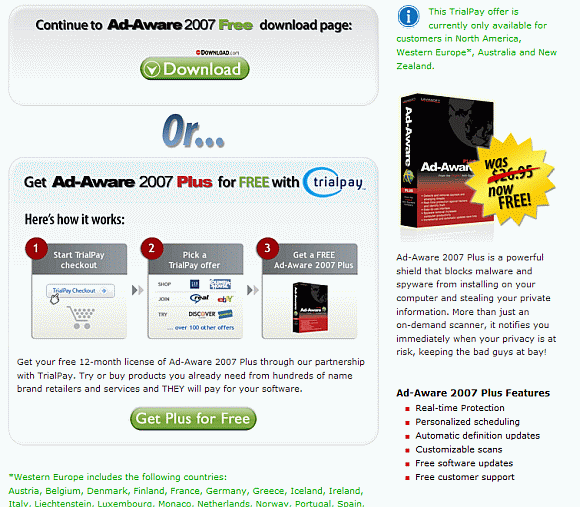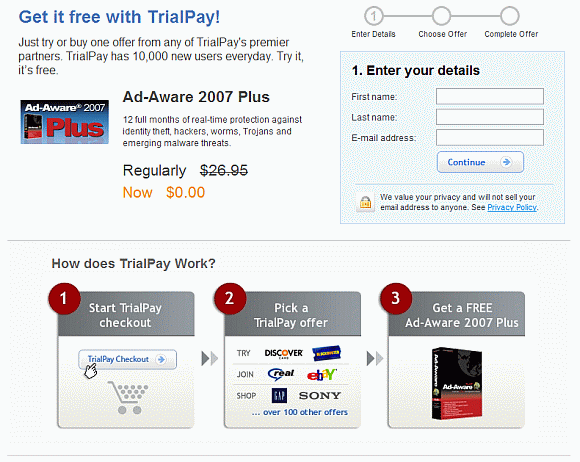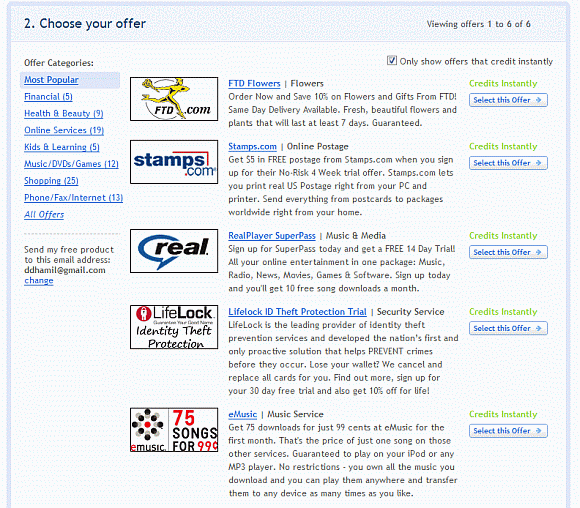(UPDATED: See below.)
 Getting stuff for free is always an attractive proposition from the consumer’s point of view, if not necessarily the greatest business model for the company doing the giving (go ahead and recall your favorite dot-com example here). Now TrialPay, a self-described arranger of “alternative payments” that just raised another $13 million, thinks it’s found a way to square that circle by updating an old department-store offer: Buy one, get one free.
Getting stuff for free is always an attractive proposition from the consumer’s point of view, if not necessarily the greatest business model for the company doing the giving (go ahead and recall your favorite dot-com example here). Now TrialPay, a self-described arranger of “alternative payments” that just raised another $13 million, thinks it’s found a way to square that circle by updating an old department-store offer: Buy one, get one free.
TrialPay gets online vendors — many of them software makers who are painfully aware that few people really want to pay for their offerings anymore — to offer visitors a free product if they’ll sign into the TrialPay service and buy something from a list of selected, and presumably targeted, advertisers. Once the purchase is verified, TrialPay emails the consumer a coupon for their free swag. TrialPay has started to attract some well-known advertising merchants to its platform, ranging from brick-and-mortar stalwarts like Citibank, Geico, Comcast and Time Warner Cable to Web-centric businesses such as eBay, eBags and eMusic.
This is still one of those ideas that sounds kind of nutty until you dive into the business logic behind it. Essentially, the merchant who actually sells its product — the “buy one” side of the deal — is subsidizing its “get one free” counterpart in exchange for acquiring a new customer relatively cheaply. (The rationale is similar to that of merchants who pay bounties to blogs and other Web sites that deliver customers through affiliate programs.) That commission is often higher than the actual selling price of the free item, TrialPay says. And as long as the average customer buys more than an item or two, the selling company also makes money on the transaction. The New York Times explains it all in detail here.
TrialPay, which is based in Mountain View, Calif., makes money by taking a cut of the commission and supposedly also does some targeting to put the most relevant advertisers in front of would-be customers. The company told the NYT that roughly 2,500 merchants now show TrialPay offers to prospective customers and that its annual sales may top $20 million. (Presumably, TrialPay is referring to its own revenues and not the total sales volume moving through its network. I’ll run that down and update. UPDATE: A TrialPay spokesperson confirms that the company is expecting total revenue of more than $20 million in 2008.))
That said, TrialPay isn’t exactly intuitive the first time you come across it. Coincidentially enough, I ended up stumbling across a TrialPay site just yesterday while downloading a free version of the antispyware program Ad-Aware. First, TrialPay snags you as you’re about to launch the free download with an offer for a free copy of the paid version:

Next, you’re asked to sign into TrialPay with your name and email address. There’s a minimum of explanation here, and at the time, as someone who’d never heard of TrialPay before, some of the language here — especially, “Try it, it’s free” — struck me as a little on the hucksterish side. In fact, it was at this point that I bailed on TrialPay, particularly since I had no idea what I’d be signing up for and how much marketing spam I might inadvertently be opting into. (Yes, the signup box says your email address won’t be sold; I just didn’t believe it.) That screen is here:
Next, you’re presented with a variety of advertiser offers, which you can sort by category and even filter specifically for merchants who’ll give you instant credit for your purchases (some credits, particularly with big financial institutions, can take a few days). Here, for instance, is what the service offered me:
Whether such offers float your boat or not is a matter of personal preference. (I didn’t end up biting on any of them.) Overall, however, TrialPay offers a pretty intriguing model, and one that several of its participating merchants seem happy with. “You can reach out into the virtual space and find new customers you wouldn’t have otherwise reached,” Gap.com general manager Will Hunsinger told the NYT. “It’s a little different model, which is something we haven’t seen come out of the Valley in a little while.”
TrialPay just raised $12.7 million in a second funding round (the release is here), for a total of $15.8 million since its founding in 2006. Investors in the latest round included Index Ventures, Atomico Ventures and former PayPal executives.
VentureBeat's mission is to be a digital town square for technical decision-makers to gain knowledge about transformative enterprise technology and transact. Learn More


